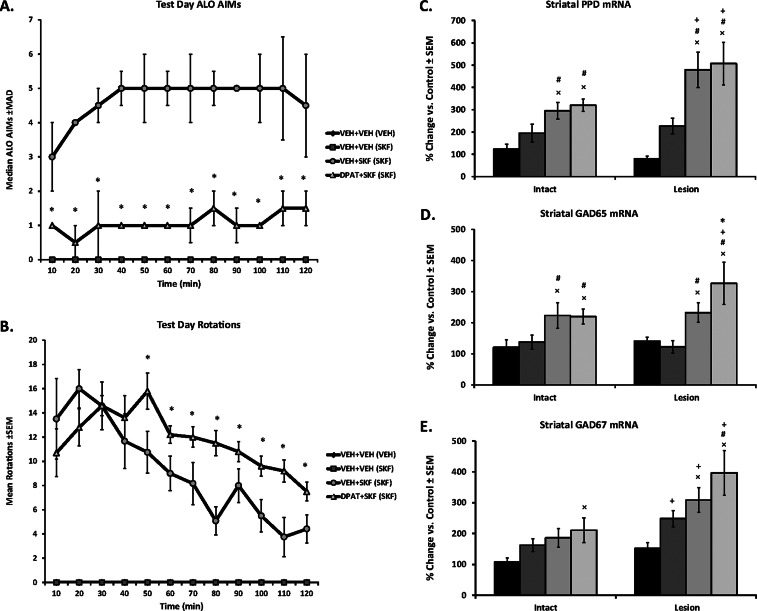Figure 2.
Effects of 5-HT1AR stimulation on striatal factors related to D1R agonist-induced dyskinesia. Rats (N = 43) in Experiment 1 received unilateral 6-OHDA lesions of the MFB and 3 weeks later were primed with Vehicle (VEH; 20% DMSO in 0.9% NaCl, sc) or the D1R agonist SKF81297 (SKF; 0.8 mg/kg, sc) every 2–3 days for a total of 3 days (priming is denoted in parentheses). Two days following priming on test day, VEH-primed rats (n = 10) received Vehicle (VEH; 0.9% NaCl, sc) + VEH. Dyskinetic SKF-primed rats (n = 32) received one of the following: VEH + VEH (n = 10); VEH + SKF (n = 12); or the full 5-HT1AR agonist ±8-OH-DPAT (DPAT; 1.0 mg/kg, sc) + SKF (n = 10). ALO AIMs were rated and rotations were counted every 10 min for 2 h immediately following injections. Treatment effects for (A) ALO AIMs (expressed as medians ± MAD) and (B) rotations (expressed as means ± SEM) were analyzed by employing nonparametric Kruskal–Wallis tests and two-way ANOVA, respectively. Following 2 h of behavioral ratings, rats were killed and striata immediately dissected and placed in RNALater for subsequent analyses of PPD, GAD65, and GAD67 mRNA using real time RT-PCR. Bars depict the effects of treatment on striatal (C) PPD, (D) GAD65, and (E) GAD67 mRNA in the intact and lesioned striata, graphed as percent change from ultimate control [intact striata from VEH + VEH (VEH)] ± SEM. Main effects of treatment and lesion and treatment-by-lesion interactions were determined by two-way ANOVAs. Significant differences between treatments were determined by Mann–Whitney post hoc comparisons for ALO AIMs and LSD post hoc tests for rotations and mRNA. *p < 0.05 vs VEH + SKF (SKF); ×p < 0.05 vs VEH + VEH (VEH). #p < 0.05 vs VEH + VEH (SKF); +p < 0.05 vs Intact side.

